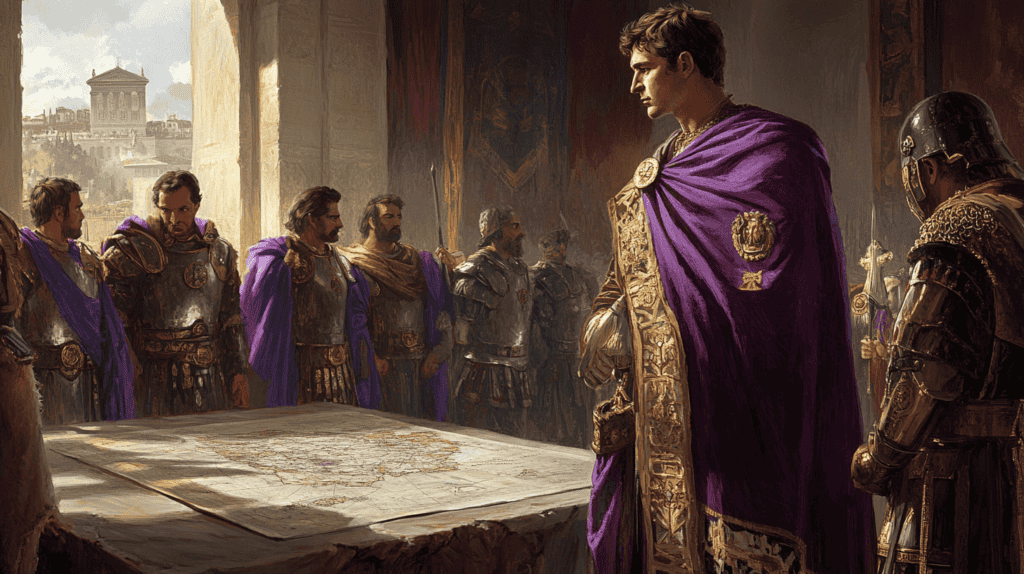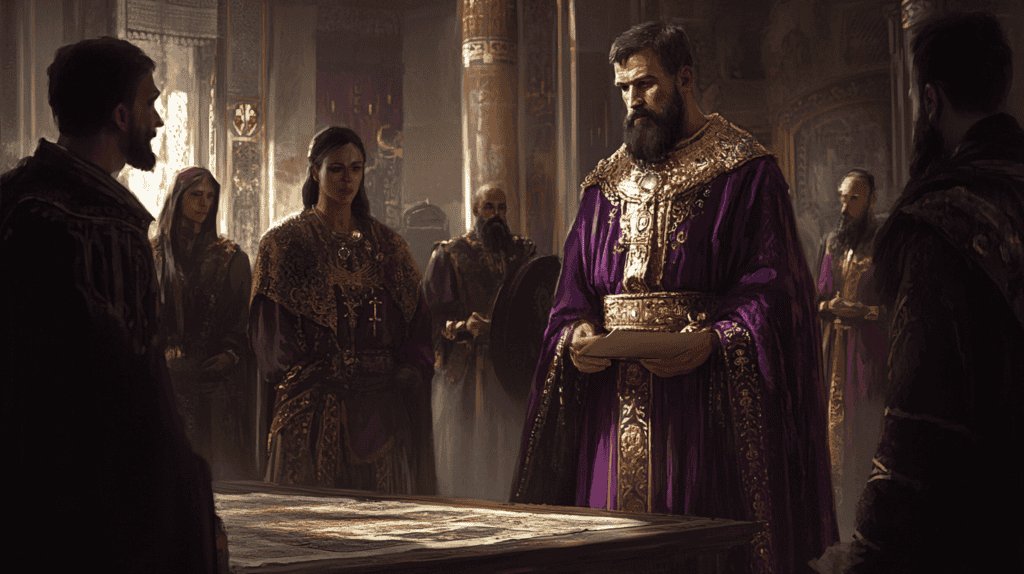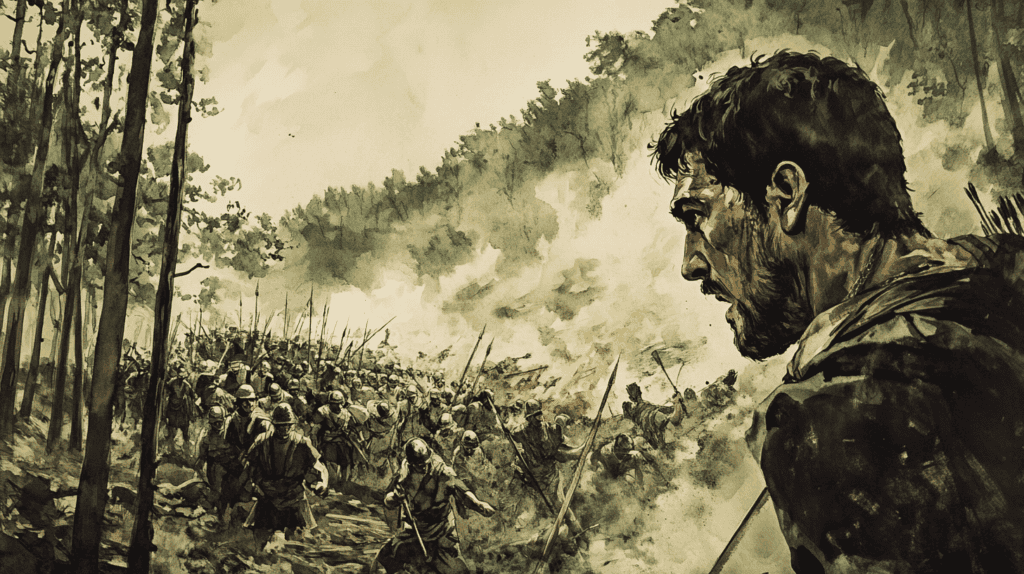
Basil II, known as the Bulgar Slayer, stands as one of the most formidable and influential emperors in Byzantine history. His reign, spanning from 976 to 1025 CE, marked a period of significant territorial expansion, military prowess, and administrative reform that would shape the Byzantine Empire for generations to come.
Early Life and Ascension to Power
Born in 957/958 CE, Basil II was the son of Emperor Romanos II and Empress Theophano. He and his younger brother, Constantine VIII, were crowned co-emperors in 960 CE, but due to their young age, they were unable to rule effectively. Following their father’s death in 963 CE, the empire was governed by a series of regents and co-emperors, including the generals Nikephoros Phokas and John Tzimiskes.
It wasn’t until 976 CE, at the age of 18, that Basil II began to assert his authority as the senior emperor. However, his path to power was far from smooth. The young emperor faced significant challenges from powerful aristocratic families and ambitious generals who sought to usurp his throne.

Overcoming Internal Strife
The early years of Basil’s reign were marked by civil wars and internal power struggles. Two formidable generals from the Byzantine Anatolian aristocracy, Bardas Skleros and Bardas Phokas, posed significant threats to Basil’s rule.
Basil’s determination and strategic acumen were put to the test as he fought to maintain his grip on power. He successfully foiled a coup attempt by his corrupt chamberlain, Basil Lekapenos, in 985 CE, resulting in the latter’s exile. The emperor then had to contend with Bardas Phokas, who declared himself emperor in 987 CE.
In a shrewd diplomatic move, Basil sought assistance from Vladimir I of Kiev, offering his sister Anna’s hand in marriage in exchange for military support. This alliance not only helped Basil defeat the rebels but also led to the creation of the famed Varangian Guard and the Christianization of Kievan Rus.

The Bulgarian Wars
Basil II’s most famous military campaigns were against the Bulgarian Empire, which earned him the moniker “Bulgar Slayer” (Bulgaroktonos). The conflict with Bulgaria spanned nearly four decades and represented Basil’s relentless pursuit of restoring the Byzantine Empire to its former glory.
Battle of Trajan’s Gate
In 986, the young and inexperienced Basil II led a campaign against the Bulgarians, aiming to subdue them with a single decisive strike. His target was the strategic fortress of Serdica (modern-day Sofia), which held a key position between the northeastern and southwestern Bulgarian lands. The Byzantine army, numbering between 15,000 to 30,000 men, marched from Adrianople through Philippopolis (Plovdiv) towards their objective.
The siege of Serdica proved more challenging than Basil had anticipated. Despite facing only about 4,500 defenders, the Byzantine forces struggled to make headway. After 20 days of fruitless assaults, the imperial army found itself running short on supplies. The Bulgarians had effectively cut off their provisions by burning crops and capturing Byzantine cattle.

As the situation deteriorated, Basil made the fateful decision to lift the siege and retreat. This decision was partly influenced by rumors that one of his generals, Leon Melissenos, had abandoned his post guarding the army’s rear to make a bid for the throne in Constantinople. The retreat, however, would soon turn into a disaster.
The Bulgarian forces, led by Samuel and possibly Roman, seized the opportunity presented by the disorganized Byzantine withdrawal. As Basil’s army made its way through the narrow pass known as the Gates of Trajan in the Sredna Gora mountains, the Bulgarians sprung their trap.
On August 17, 986, the Byzantine army found itself surrounded in the densely wooded and rugged terrain. The ensuing battle was a catastrophe for the imperial forces. Large numbers of Byzantine soldiers perished, and the rest were captured along with the imperial insignia. Basil himself barely escaped with his life, saved only by the efforts of his elite Armenian infantry unit.

The defeat at Trajan’s Gate exposed the vulnerabilities of the Byzantine military under Basil’s early leadership. The emperor’s inexperience was a crucial factor in the disaster. He had made several critical errors, including encamping too close to Serdica’s fortifications, failing to neutralize Bulgarian garrisons in the nearby mountains, and conducting a haphazard retreat that invited attack.
The defeat at Trajan’s Gate had far-reaching consequences. It emboldened the Bulgarians, leading to a decade of expansion in the Balkans at Byzantine expense. For Basil, it was a harsh lesson that would shape his future approach to military leadership. This defeat, however, did not break Basil. Instead, it spurred him to become the formidable military leader history remembers.
Battle of Kleidon
The turning point in the decades-long war came in 1014 CE at the Battle of Kleidion. Basil’s forces, led by the capable general Nicephorus Xifias, out-maneuvered the Bulgarians and achieved a decisive victory. It was in the aftermath of this battle that Basil earned his fearsome reputation.
The battle took place in a strategic mountain pass near the modern Bulgarian village of Klyuch. The Bulgarian forces, numbering around 15,000 to 20,000 soldiers, had fortified their position with a thick wooden wall. This formidable defense initially repelled Byzantine attacks, forcing Basil II to reconsider his strategy.

Faced with a seemingly impenetrable defense, Basil II devised a cunning strategy. He ordered his general, Nikephoros Xiphias, to lead a contingent of troops around the high Belasitsa mountain, outflanking the Bulgarian position. Meanwhile, Basil continued to assault the wooden wall, keeping the Bulgarian defenders occupied.
On July 29, Xiphias’ forces emerged behind the Bulgarian lines, catching them completely off guard. Trapped between two Byzantine forces, the Bulgarian soldiers abandoned their fortifications in a desperate attempt to confront this new threat. This was the opportunity Basil had been waiting for. His troops breached the weakened defenses, and the battle quickly turned into a rout.
The aftermath of the battle was marked by an act of shocking cruelty that would earn Basil II the moniker “Bulgar-Slayer.” According to historical accounts, the Byzantine emperor ordered the blinding of 14,000 captured Bulgarian soldiers, leaving one in every hundred with a single eye to lead their comrades back to Tsar Samuel. This brutal act was designed not only to punish but also to demoralize the Bulgarian leadership.

The impact of this defeat on the Bulgarian Empire was devastating. Bulgarian Tsar Samuel, upon seeing his blinded army return, reportedly suffered a heart attack and died two months later. While the war did not end immediately, the Battle of Kleidion marked the beginning of the end for the First Bulgarian Empire. Over the next four years, Byzantine forces systematically dismantled Bulgarian resistance, finally bringing the empire to its knees in 1018.
By 1018 CE, Basil had fully incorporated the Bulgarian lands into the Byzantine Empire, effectively doubling its size. This victory marked the zenith of Byzantine power in the Balkans and restored the empire’s Danubian frontier for the first time in 400 years.
Eastern Campaigns
While the Bulgarian wars were Basil’s most famous military endeavor, he also conducted successful campaigns on the eastern front. He maintained Byzantine positions in Syria against Fatimid aggression and made territorial gains in Georgia and Armenia.
Basil’s eastern strategy combined military action with shrewd diplomacy. He secured land from Georgia and Armenia through both conquest and negotiation, laying the groundwork for future expansion. His campaigns stretched Byzantine influence into Mesopotamia and consolidated control over newly conquered regions by reorganizing them into new imperial provinces.

Legacy and Impact
Basil II’s reign marked the high point of the Byzantine Empire’s power and influence. At the time of his death in 1025 CE, the empire stretched from southern Italy to the Caucasus and from the Danube to Syria.
Basil’s military achievements were substantial. He not only reconquered Bulgaria and expanded into the east but also strengthened Byzantine control in southern Italy and laid the groundwork for the reconquest of Sicily from the Arabs.
His approach to warfare, characterized by meticulous planning and disciplined execution, became a model for future Byzantine military operations. As historian J.J. Norwich noted:
“Success for Basil depended on faultless organisation. The army must act as a single, perfectly coordinated body. When battle began, he forbade any soldier to break ranks. Heroics were punished with instant dismissal.”

The Man Behind the Legend
Despite his towering historical presence, Basil II remains something of an enigma. Unlike many of his predecessors and successors, he never married or had children, dedicating his life entirely to the service of the empire.
Basil was known for his austere lifestyle and single-minded focus on governance and military affairs. He eschewed the lavish trappings of imperial power, preferring simple dress and a frugal existence. This ascetic approach to rule was reflected in his governance style. Basil was hands-on, personally leading military campaigns and involving himself in the minutiae of administration. His work ethic and attention to detail became legendary, setting a high standard for imperial governance. Unfortunately, without a capable successor to continue his policies, many of Basil’s hard-won gains were soon undone




